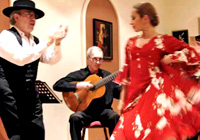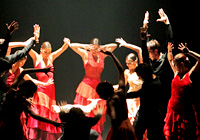Flamenco is one of the most characteristic elements of Spanish culture, especially throughout the southern region of Andalucía. That's precisely why several of our schools offer a one-of-a-kind Spanish + Flamenco course, where you can learn Spanish while learning how to dance flamenco. What better souvenir to take home with you? Learn more about this unique course and where it's offered right here: Spanish + Flamenco Course
And you can also find here all the different meanings of the word flamenco.
Flamenco dance history
To point out the stomping feet and fiery passion is merely brushing the surface of flamenco dance. Flamenco dance, as one-third of the quintessential Spanish phenomenon of flamenco, has an extensive historical background that parallels the cultural development of Spain itself.
Hailing from southern Spain's outcast populations, flamenco dance and music drew early influences from Greek and Roman and later from Indian, Moorish, and Jewish cultures. With the arrival of the Moorish and Jewish populations to the Iberian peninsula centuries ago, Andalusia's already thriving music and dance inadvertently began extracting characteristics from the newly-arrived populations. The flamenco dance and music that we see today are the dazzling results of centuries of absorbing and flawlessly sewing together elements of this myriad of diverse cultures.


With the flourishing development of flamenco music emerged the equally rapid evolution of flamenco dance, which first appeared recognizeably as a structured dance in the 18th century. While flamenco's design in its origin revolves around the hearty voice of the singer, the impassioned flamenco dancers stunned audiences in special music cafés - called cafés cantantes - and quickly began stealing the show. Centuries of cultural melding later, what ironically began in caves as a form of personal expression by gypsies and other oppressed ethnicities has evolved into the flashy flamenco dance and music that has taken the world by storm.
Flamenco Dance Technique
Flamenco Dance
While the common denominators of passion and fervor never waiver, there is no one single flamenco dance. In fact, depending on the criteria of mood intention, the set of melodic phrases and the cultural traditions behind each song, flamenco dance actually manifests itself in more than 50 distinct palos (types of flamenco dance)! Both flamenco music and flamenco dance involve a great deal of personal improvisation which takes its form through the spontanteous expression of the performer's emotions at each moment of the performance. However, personal expression must adhere to the strict framework of flamenco music's traditions and rhythmic patterns.
Flamenco Dancers
In a flamenco performance, the dancer - or bailaor(a) - will often stand motionless for the first moments absorbing the strums of the guitar, the clapping, and the singing until the inspiration hits him/her. Then he or she will launch into a flamenco dance every bit as passionate as the song being belted out by the cantaor- you can even see the explosion of emotions in the dancer's facial expressions thoughout the performance.
The role of the flamenco dancer is essentially to physically interpret the words with light, graceful arm movements that contrast the reverberating steps as feet drill into the floor with a bewildering intensity. Duets, performed by a man and a woman, are often the most vivid flamenco dances. The dancers keep their eyes firmly locked each other, constantly and aggressively building off one another in what becomes competition of passion, sexual tension, and emotion.


